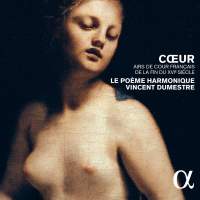Texte paru dans: / Appeared in:
|
||||
|
Outil de traduction ~ (Très approximatif) |
||||
|
Reviewer: Barry
Brenesal Around the same time as the Italians were crafting more folk-influenced songs in the latter part of the 16th century—Vecchi, the canzonetta, Gastoldi, the balletto—the French began exploring similar musical territory. Airs de cour, Adrian Le Roy called them in his 1571 publication, Livre d’airs de cour miz sur le luth. By way of contrast to the “difficult and arduous” chansons of the day (Le Roy mentions Lassus), he says of his works that they are a “much lighter little collection of court chansons, which were formerly called voix de ville.” These were to become extremely popular for several generations, with their binary forms, simple melodies, and mix of widely different poetic texts that included everything from lovelorn laments to toasting the pleasures of convivial company. As time passed, the air de cour became increasingly refined, though the greatest distinction between these early pieces and those of a popular mid-17th-century composer of airs such as Étienne Moulinié is the increasing use of Italianate divisions. What we have here, then, is a collection that concentrates for the most part on the air de cour’s early decades, when it was arguably at its most emotionally direct, and most beholden to the music of the towns and countryside rather than the courts. There are 12 vocal selections in all, and three instrumentals. The performances are typical for Le Poème Harmonique, so if you’ve heard any of their previous albums, live concerts, or listened to them on the Web, you know exactly what to expect: technical expertise and an emphasis on expressive communication. The eight instrumentalists cover recorders, bassoon, viols, harp, harpsichord, violin, and guitar. The four vocalists (CT-S-T-BAR) are led as often in the past by Claire Lefilliátre’s agile flicker-vibrato soprano, which can sound fragile or soar above the company seemingly at will. A point to note is how, folk influences to one side, the sophistication of these arrangements work to provide a broad sampling of colors. The introductory verse of the haunting Les mariniers adorent is given to the guitar with harp accompaniment; that of Tant et tant, to the harpsichord. Most pieces are sung by three or four singers, but both Le Roy’s Ó combien est heureuse and Guédron’s Belle qui m’avez blessé are taken by one, the first with harp and guitar accompaniment, the second with guitar alone. The first verse of Caiétain’s Mais voyez mon cher esmoy is sung a cappella, which brings out a startling similarity at one point to some far older, long discarded harmonic procedures: survival or distortion, your choice. The three instrumentals on the album include one selection for three gambists, and two selections that emphasize the harp and recorder. The narrowness of the genre doesn’t prevent Vincent Dumestre from devising clever, appropriate textural variety. These weren’t the way the original audiences heard these selections, but then, we’re not those audiences, and the arrangements are managed stylishly, and with tasteful restraint. My only criticism of the album is the use of a nasal “funny” voice that tenor Serge Goubioud employs in the very un-PC Allons, vielle imperfaite, along with a brief foray into speech-song. It demonstrates a difference between the live concert and recording mediums: What works well when seen and heard once on stage is amusing the first time through on an album, then quickly becomes labored and annoying on repeat. This isn’t to say that singers should not characterize songs, but that there are ways to do so (dynamics, accenting, resonance) that draw less attention to themselves and stand out less over time. The liner notes are brief. Texts and translations are provided, though white text on a pink background for some reason leaves me feeling as though I’m reading bubblegum. With music and performances this engaging, a recommendation is assured. | ||||
|
||||
|
|
|
|||
|
Cliquez l'un ou l'autre
bouton pour découvrir bien d'autres critiques de CD |
||||




